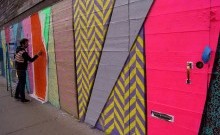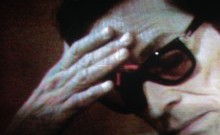A Chain of Attractions
A gang can be hard to come by, let alone one that has your back. Belonging, & a conscious sense of that belonging, can be a rare force to capture & harness. In tireless struggle, so much of what comes to pass through our experience as we cross the mires of higher education, to a place somewhere between being a working artist & a highly functioning adult, is determined by our time in institutions of one form or another. Just as the gang can function in the family’s stead, while some students of the arts yearn to be free of the trappings of university life, some may fear for the day when they have no rudder, no constructed architecture of demands & requirements there to guide their creative paths by motivation (& by fear of a failing grade). More importantly, the questions asked in the process of any education can be as important as their answers, if they are to be found at all. They can be formative, serving a slowly edifying awareness, & there is a special rumination that occurs only within the specific confines of a community, one where the student feels safe, protected, & welcome. This particular seminal process is difficult to attain in the first place, if not impossible to replicate beyond any Conservatory-bound experience.
Founded in 2010 by friends & collaborators Aaron Finbloom, Abraham Avnisan, & Matheson Westlake (nee Claire Epstein), with its first session taking place the following spring on a 10-acre tract of Catskill land, the School of Making Thinking is described by its founders alternately as “an artist/thinker residency program, an experimental college, and a nomadic investigation in intentional living.” In its fifth straight year, having graduated from its infancy with four successful summer programs under their belt (consisting of two intensive 2 week sessions & 18 accepted applicants from a variety of arts disciplines & creative fields), & a newly minted Board of Directors — convened 2 years ago & made up of the program’s alumni & other members of the creative community — SMT (as it’s collectively & affectionately known amongst its members) seems to be in the constant process of just such replication, recreating the comfort & nurturing support of a self-sustained institution. A community of artistic peers, albeit one that occurs only annually & for a set period of time, SMT runs almost solely on the energy of its applicants & Directors, with limited external financing. We spoke with founders Finbloom & Westlake, along with SMT Board Members Sophie Traub, Josephine Decker, Sharon Mashihi, Mollie McKinley & alumni/affiliate Kaitlyn Prest , for an extensive look at their history, methodology in practice, & the curation process.
Featured Cast of Characters:
Aaron Finbloom : Founder, Executive Director, philosopher, musician, performance artist and educator.
Matheson Westlake : Founder, Board Member, teaching artist, writer, performer, and theater director.
Sophie Traub : Board Member, Director, Performing Artist, Actor
Josephine Decker : Key Affiliate, SMT Session Leader, Event Coordinator, Writer, Director, Actor.
Mollie McKinley : Board Member, Director, Interdisciplinary Artist
Sharon Mashihi : Board Member, Director, radio producer and screenwriter.
Kaitlyn Prest : SMT alumni & affiliate, audio artist working in radio, performance and installation.
on beginnings
AF: The way I became involved was as a founder. I was in a grad school program at the time- a master’s program in Philosophy. I was also very invested in art practice. And I was becoming more and more interested in ways of combining the practices of philosophy (or academia, or thinking) and the practices of art…. I wanted to build a community of people who were invested in this exploration.
MW : We all lived in Bed Stuy, and eventually in the same apartment. We rented a fixed-up barn and farmhouse outside Delhi for the month of June, set up an application process, raised money on Kickstarter... There were a million technical details. Abe named it. It was Aaron's idea. I opened up my social network. At the time, my greatest desire was to be admitted to an MFA program for writing. I was rejected by 19 schools over a period of two years, and the one school that did accept me-- California College of the Arts-- was too expensive to consider attending. Tens of thousands of dollars in tuition, more debt than I could pay back. SMT cost $150 a week for room & board the 1st year-- an amount we figured anyone in New York could make by subletting their apartment. One way we curated our group was by keeping it cheaper for residents than it actually cost us to run the school, which would have been prohibitive for the people we hung out with in New York. So, we crowdsourced the funding.
JD : Matheson was someone who I knew from 2008. She had invited me to apply, & I applied. The irony of it is that on the bus ride up there, I started thinking to myself, Why am I doing this? There’s so many other important things I should be doing with my life, & then I got up there & it was the best 2 weeks of my life. As an experience, it was really loving & artistically expansive — I decided I was going to make a film, that that was something I really wanted to do, & I decided to make Butter on the Latch while I was up there, & 3 weeks later we were shooting, so SMT really opened it up for me. I’ve gone back every summer since then. It was different than other residencies that it was more collaborative than focusing on solo work.
ST: I became involved in 2012 — my friend Adriana [Disman, artist & SMT board member], was going with Josephine to SMT in 2011, & told me I should apply the following year. And I applied as a musician actually. I had been playing, very experimentally, with making music, & I came with that intention. And similarly to Josephine, my experience at SMT was extremely expansive, & a few months later I ended up meeting Josephine & acting in her film, but connecting through the community there. I did make some music when I was first involved, but it was one of the first experiences I had where it highlighted every aspect of what I was doing as my practice, so I ended up doing a lot more performance work & acting than music, which wasn’t how I had planned it. I think I was nervous. But coming in the second year, it was heavily endorsed by Adriana. I think if anything I was very nervous about my own validity coming in, & that my experiments as a musician were… I just wasn’t sure, & I was really hoping it would work out.
SM : Right before SMT began… I was going to radio school, I had this idea of myself as a free spirit, but I didn’t use the word artist, even though I went to film school & was working in the arts, I didn’t think of myself as an individual artist. And I was really at a point in my life when things just weren’t working out, & I was actually trying to get a straight job. It’s funny because I’m from New York, but I was applying to weird jobs in places like Indiana, & then I went to SMT & it was just like, I actually love doing this, & I now have a way of doing this.
MM : In 2009-2010, I was involved with the early days of the Bruce High Quality Foundation University (BHQFU) in New York City, where I taught a class called Occult Shenanigans along with artist and educator James Brittingham. The larger mission at BHQFU is to be a learning experiment for artists as well as a foundational site for conversations between artists outside of the commercial art world or of the MFA system. While at BHQFU I heard about SMT, which was accepting applications for its first residency season. That inaugural year of 2011 I was the only resident not already socially connected to the founders, and something happened that was really singular and resonant with that group from the summer of 2011. It felt akin to a Black Mountain College-style fantasy of living, learning, and making that I’d always had. A core group from that first summer now acts as the Board of Directors. After 2011 I was also a return resident, and teacher of a class called “Ritual and Ceremonial Time,” which investigated an intersection of existential philosophy with mysticism. Since the inauguration of the Board in 2013 I’ve been an executive board member.
KP : I make radio, that’s all I ever do. I have a podcast on a network that’s called The Heart, & it’s been the great achievement of my unfolding adult life…Radio was really my jam, & I moved to New York, met Sharon at a radio event… I remember the first time meeting the SMT community — even the first moment walking into this house — before that I had this idea of what being a creative adult would actually mean, that it meant one thing. When I lived in Montreal before that, I always thought of it that way, that it meant one thing to be an artist. And I didn’t really see myself in that. I also felt that way about activists. And I remember meeting Sophie & Josephine & Sharon & Finbloom, & it felt like they knew what life was about… When you step into a room with this caliber of person, it feels really good.
Sharon Mashihi
what it is & what they do
AF : Very quickly, after the first couple summers, SMT turned into a much bigger collaborative vision- a vision shared by our 8 board members. I would say at this point, I was still a big part of the dream and mission, but this was now shared.
SM : It was intended to bring academics & artists together — so those who had a more thinking practice were invited to bring more making into their thinking, & those who had more of a making practice were invited to bring more thinking into their making. So the first applications were really asking us to engage with a work of literature, or a lineage of thought, or a thinker, & to figure out how we were gonna use that to decide what we were going to make….
MW : I'm essentially co-leader, housekeeper and moderator, as well as participant artist. We set people up in bedrooms, show them where they can set up their workspaces, give people free reign around the property and the house, set meal times, organize the collective cooking and cleaning efforts. We assign a few deadlines and help people plan interactive workshops.
SM : And there was really no way of knowing just how it was going to work — it was two weeks, we had rented a house in the Catskills, & we didn’t all know each other, but what happened was we all bonded really quickly. And in just those initial two weeks, a culture formed that, while it has changed a little bit from where it started out, it is still devoted to the same idea: You live together in a house, literally right on top of each other, & that first year, it was a small place with a lot of land. So there really wasn’t an individual space for everyone, it’s not the kind of place where you have a studio & a desk. Mostly you find a place to sit outside or in the house, & during the day you did your own thing, & at night we would come together in the house. We would have dinner every night made by two people, there’s cleanup, & really once you enter SMT you really don’t leave the grounds. We think of it as a place in four parts — part experimental college, part summer camp, part artist residency, & part intentional community.
ST : I came in the 2nd year & I feel like the way it worked was sort of as a conversation about what things were going to be successful & what things were successful the 1st year. So again there was an emphasis on collaborating, & how to make a good project collaborative, & then that could be literal, or just kind of in process, or doing a workshop… There’s these really wonderful exercises that if I’m not mistaken were developed by Findbloom, based around idea exploration. There was one where we all sat in a circle, & everyone writes an idea that is central to their project on a piece of paper, like on the top of a packet, & then you pass around the packet & each person has 10 minutes, 10 minutes with each packet, & you just reflect & then you are left in the end with 10 people’s ideas & reflections upon your central, initial question. Not only do you create this community around your curiosity, but you’re supported in your investigations, you’re also planting the seed of your curiosity amongst the group. So there’s this amazing crossover & synchronicity, which isn’t necessarily the point of it, but the pieces end up influencing each other, just through happenstance.There certainly ends up being a lot of something being collectively made just as there is something being individually made by each of us.
MW: At SMT I'm essentially co-leader, housekeeper and moderator, as well as participant artist. We set people up in bedrooms, show them where they can set up their workspaces, give people free reign around the property and the house, set meal times, organize the collective cooking and cleaning efforts. We assign a few deadlines and help people plan interactive workshops.
SM : This weird thing happens there where working & hanging out becomes this strange hybrid thing. Sometimes some spontaneous performance I would find myself doing during the day, by myself, that will bleed into whatever film I’m working on. You’re in a space with all these artists, & constantly at the tip of inspiration. A joke becomes something serious, something that you can base a whole piece of work off of that that has its own life outside of it. It’s not like it is in New York, where you get a bunch of people together & have a meeting & say this is what I’m thinking of doing, do you want to be the producer, do you want to help me do this? That’s why the dinners are important. And that first year we had the mandate that everybody’s work had to be collaborative. I had the assignment that whatever I did, it had to involve Josephine, & Josephine had to involve me. And our work inspired each other.
JD : We didn’t even realize we were, but a lot of people there were interested in ritual, & almost everyone there developed a pretty intense ritual. Adriana did a performance where she was naked, & stayed upstairs in the barn, & invited each of us to come up there one at a time. Rachel did a radio performance & I was naked with antlers in my hair… I feel like we infused the place with rituals, & I feel like that was a way of making people vulnerable & just being in that place… It was meaningful & helped us all come a little bit closer.
SM : It’s not the point of it, but to think how out of touch I am in my room when I’m coming up with an idea & shaping it, & how much more true something feels when it’s of a space, a space that we create, a space that’s made by us — that said, any idea I have or any impulse I have, comes out of the fact that I’m feeling so in tune with all these people, & so these exercises, in a way they’re not the point, but they are the reason why I feel like so much of the work that comes out of SMT is so strong. Or certainly the work I make there feels stronger than the work I make when I’m on my own.
KP: For someone working outside of the institutional framework that’s set up for making the kind of work I do, reproducing an institution that’s outside of the institution, surrounding yourself with people you choose, that can be really important. Motivation is more important than time — you can have all the time in the world, but without the proper motivation, nothing happens. Surrounding yourself with people who fuel your inspiration & creativity, will give you something that all the time in the world can’t provide. That’s something that I think is really important — creative people who are trying to do something different.
MW : I lose myself and find myself in the group all the time. What I like about SMT is that we tend to share knowledge and experiences horizontally rather than vertically. Hierarchy is not emphasized at SMT. Consensus is the aim. Nothing is mandatory. But we do offer structures we hope will be helpful, and there's a certain kind of "handing down" happening there. We have a chair at meetings. Finbloom's vote gets a little extra weight since he's the founding executive director and works like a horse.
AF : In terms of “what I do there” I’d say that I help plan things. I help make sure all the logistics fit together and the programs can run successfully.
KP I make what I know how to make or what’s easy to make a lot of the time, & being at SMT has forced me out of that in a way, & also, as we’re talking about influences, just being around other minds that I’m not typically around… One of the things I like about it is it is so interdisciplinary & such a wide array of different talents & people coming from different worlds & different perspectives, I would say that really influences me. It’s a fuel for creativity, just in changing the way you go about your day.

Sophie Traub
individuated limitations, collective inhibitions
MW : The reason I keep reviving SMT for myself every summer is that I love to be surrounded by a group of artists and thinkers who are all working in different forms: conversation, group activity, performance, mark-making, video, creating ritual, recording interviews. People are 90% self-directed within our 10% framework. The staff are unpaid.
AF : Collaboration, community, together certainly has limits. In fact, our goal at SMT is about finding the middle ground. So yes, there are moments when the balance is tipped too far in terms of community. There are moments when I wish to be alone. And as noted, navigating one’s way through these challenges can be a rewarding struggle. [But] It's important to note that the way we structure SMT is not as something that could last for an entire year. Our networks of togetherness are formed and then dissolve. This process is essential. But I think there is a great power in the leaving, a great power in withdrawing.
MM : Each member of the collective SMT core has influenced an edge of my work and my being. I think we’re living in an age where the obsession with the isolated individual experience is becoming obsolete. Instead, a collective consciousness is articulated through individual experience and vision.
MW : I feel less fixated on being original in the context of a collective. In a group, it's so apparent that everybody's programmed differently. We can't help being skewed in our own directions. My artistic practice churns to life when I'm surrounded by creative ideas in action. The limitation I'm most grateful to shed is the fearful part of me that doesn't want to show anything before it's ready to stand alone as a work of art. At SMT there's an understanding that everything is unfinished, messy, in-progress-- and it's not expected for your work to show anything but the path you traveled.
KP : That was something I was considering before I came to SMT, so I would say that the community of SMT allows for experimentation, to do things you would never have even thought to do before, but births it in a setting where it feels safe to do that & where you have support & people giving you positive reinforcement….There’s no way in fucking hell I would even have found the time to do that without SMT. I say all the time I’m going to develop more performance based & installation type work, I say it to myself every single day, but I never would have actually done it if not for SMT, & being around the people there & doing that kind of work…. Thinking about collective experience, how challenging it can be to engage with so many individuals in a group.
Mollie McKinley
rule of thought in practice
AF : Thinking has certain strongholds in the west. One of them is academia. Another is science. These two strongholds overlap somewhat. Both have to do with that which is worded. And not just any words. Words used in a specific way and specific context. Intellectualized, specified, subtle, definite wordings. Wordings that are wrapped up in these specific cultures- the scientific and academic. This is what I am interested in subverting. My own work is about finding new ways of practicing philosophy. This usually involves explicitly playing with the components of a philosophical conversation. How can we be artists with philosophy? How can we treat concepts, modes of speech, gestures, dialogical environments, as colors of a pallet in the way a painter might? As a collective I think all of us are exploring ways of subverting the dominant culture of thinking. Thinking happens in community. Thinking happens when you least expect it. Thinking happens alongside the immense feelings of being in a community. Our environment changes how we think. What happens if every summer we shift our environment, if we shift how we exist together? Then wouldn’t we, every summer, change how we think?
MM : My modes of approaching philosophical inquisition are more experiential than academic. It was only at SMT that I finally felt that it was possible to articulate philosophical questioning through contradictions, texture, and failure—rather than through academic arguments and the need to prove specific theorems…. Another crucial aspect to the subversive mission at SMT is that of actively creating and finding community of like-minded people, rather than relying on MFA systems to artificially produce that sense of “a movement” within a generation…. I believe in the tradition of great artists being made of life experience, struggle, trauma even. How are you supposed to make meaningful work without fucking up in the world first? These questions about institutionality versus the process/mess of real life are why I am on the board of SMT. It gives me the power to challenge the status quo.
MW : I'm less concerned with having a plan up front, and more interested in returning again and again to what intrigues me, knowing there's no such thing as wasted effort on a worthy experiment.
Existential Marina (2011 --- Mollie McKinley Summer Residency)
goals
ST : I think there are certain assets at SMT that maybe have a time limit on them. One of them is a Board of 7 people willing to volunteer their time. I just joined last year, but the rest of the Board formed 2 summers ago. Maybe they need a break, straight up. We definitely rely on fundraising, & we're able to break somewhat even… But the priority has not been to make money. The priority has always been to create the type of community that's been created. And to have an experiment & a conversation with that type of community. The questions of sustainability, fiscal sustainability, are answered through the process of running the thing, slowly. Rather than this being an entrepreneurial thing. How do we keep doing this? We only have so much energy.
AF : There are other ways to imagine and re-imagine us reaching our mission statement. I think now I imagine SMT more as this nexus of interactions. A whirlpool of creative intensities. What is the ultimate accomplishment? To activate even more untried dimensions of being-together, thinking and art-making. To go again and again and again, and each time to make a new discovery.
SM : We’re still a young organization, & can only take so many people each summer. The house we use is small. So what we have to figure out is what it really means to accept people, & expand our idea of what that is. Based on talking to people & getting an idea of where they’re headed, we can get a sense of what they might get out of it. We’re talking about SMT now, but we all also happen to be close friends who’ve decided to live in a house & collaborate outside of the group, which not everyone in the group does.
MW : We like keeping it small. As far as our residencies, we find 12 people for a 3 week session in the summer is pretty ideal. Just in terms of "feel". As long as there is no money, and we can't pay ourselves, I think you can expect changes, but not dramatic growth.
AF : Perhaps more practically our goals would be to gain greater recognition and financial compensation for these discoveries. But, yes I think it will continue to grow and change in perpetuity. The question is merely, how far can its shape shift before it is unrecognizable? I’m not sure. We’ve only been around for 5 years. Time will tell. I don’t think expansion or exposure feels threatening. Its much more the opposite. We are threatened by a lack of expansion and exposure. What if we keep doing this and after 10 years, still nobody acknowledges the great things we are doing?

the curatorial component
MW : We maintain an online presence and advertise ourselves to find new people. We did that from the beginning. But our 1st summer, we only found about 1/3 of our residents that way. About one third ended up being friends that I invited to apply, and another third were collaborators of those friends. Many of those connections were newly forged.
SM : What has organically happened is that the people who stayed the closest, the most closely involved, are close friends, or become close friends because of SMT. We do see ourselves as an Arts Organization, so we try to accept people who will succeed at SMT, & what we mean by succeed is largely that they will be the ones who like it there. So, contribute to the group, & benefit from the group. It’s complicated because we don’t want to choose people who are all alike, or people who are all closely related to us already.
AF : I don’t necessarily think of myself as “an elite few.” In fact, being an organizer at SMT usually means that we cannot do as much of a creative project. By making SMT a creative project a great danger is that our own individual art projects can be given less time. I think this is something that makes SMT very unique. Most other organizations I encounter have people in the organization that feel as if running it IS the work. The creative project IS the organization. I feel this way a bit. But cannot, and never will be able, to go all the way with this. I am too tied to my roles as artist. Which for me means being able to work on a project specific to my interests- molding conversation, reworking philosophy, scoring dialogue, etc.
SM : We’re still a young organization, & can only take so many people each summer. The house we use is small. So what we have to figure out is what it really means to accept people, & expand our idea of what that is. Based on talking to people & getting an idea of where they’re headed, we can get a sense of what they might get out of it. We’re talking about SMT now, but we all also happen to be close friends who’ve decided to live in a house & collaborate outside of the group, which not everyone in the group does. We’ll have people who we might want to know closer, & then those who we can tell might never get to experience something like this in their life, & that this might help them.
ST : There’s a Board, a screening & interview process, we have meeting after meeting, collectively talking through each application, going over each applicant. And each Board member brings a different value system to the table as well. Some are invested in the growth & establishment of SMT in the arts community, & then others are more interested in the social, intentional community building aspect of it. Who is involved, how can we make it inclusive, etc. The questions become bigger & harder each year. This year we are trying to address things that came up last year. If we have 5 young people, all fresh out of University, & 4 of them are already supported by an institution, & 2 of them already have insanely prosperous arts practices, but 1 of them isn’t supported at all & might actually benefit enormously from this experience in a way they have no access to currently, then that’s the person we might choose. It depends on the conversation, but those are the factors that come in to the dialogue.
MM : If you have a place in which to be totally vulnerable, fully seen, and accepted for what you do, it’s a lot easier to go back out into the brutal spheres of the art world, the film festival circuit, your day job, et al and feel a lot more comfortable with the possibilities of failure and success…. SMT is like a woman with a really strong personality—she repels some people, she seduces others, she waxes and wanes with her own shifting moods…. So not everyone fits into our ethic or our social vibe. We do make great strides to make people feel accepted and welcome into a community where there is a lot of pre-existing intimacy and a developed language of a micro-culture. Moving forward, I'm particularly interested in seeking new ways to curate/integrate the social and theoretical concepts we discover back into the culture at large; I'm interested in seeing how art and film history are affected by the creative collisions that occur because of the SMT think tank.
AF : Curating our summer sessions is one of the biggest joys of SMT. How do we curate it? Well, its quite easy to say how we curate our residents. There are 3 factors: 1) past accomplishments as artist and thinker 2) how well do you fit in with our mission statement and session 3) are you comfortable with collective living? Curating the structure of a session is much more involved task. The seed of this curation is the artistic seed of each summer. That moment, in the year, when you sit in a coffee a shop, and you daydream off, and think “what if.” That is the seed. For me, last year, I dreamed, “what if we all had only 1 text…what if it was only one book we could work with and we delved SUPER deep, and we formed a whole community where we all were reading each other’s books and getting excited about each other’s ideas?” The curation is about thinking about what is the best environment to nourish this idea seed --- How would each day need to look? Each morning? Each afternoon? What sorts of workshops should we have? What sorts of project goals should we set? All these questions, all these logistics become a pleasure to work with.
MW : It was a chain of attractions and chance affinities that have become elaborated and interwoven in the years since. And as we've all move into new territories, we come in contact with people who thrill us with their smarts and sensitivity and we invite them to apply. There are no guarantees to our application process. Often our friends apply and we feel we can't just populate SMT with our friends, and have to prioritize bringing in fresh influences. And then they become our friends, and the problem continues. Maybe that's how we'll grow.
Thou Wast Mild & Lovely (2014 --- dir. Josephine Decker, starring Sophie Traub)











